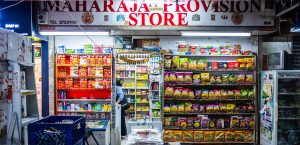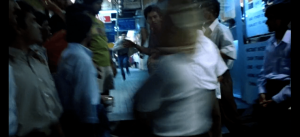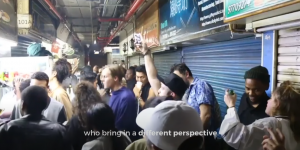Wong Kar-wai’s Chungking Express explores the confinement and loneliness felt living within Hong Kong’s urban space, but coincidentally shows how the confined space between characters can offer affection amidst the isolation. While the film can be seen as a romance film, distinctively none of the main characters get together romantically. Despite characters constantly being in close proximity to each other, they still yearn for a romance amongst their loneliness within this urban landscape. Taking place within the Chungking Mansions in Tsim Sha Tsui, the film also highlights the racial diversity within Chungking Mansions and its cosmopolitan nature. Wong throughout the film uses cinematography and character interactions to illustrate the physically close, yet isolating environment of Chungking Mansions.
Wong presents the racially diverse urban landscape of Chungking Mansions throughout the film. Chungking mansions in real life is known as the epicenter of globalization of Hong Kong, containing various restaurants, money exchange services, hostels, etc. Indians, Africans, and other ethnic minorities are the

main residents within the building complex, setting up restaurants and other stores within. This means that language communication within the urban space is diverse, which is highlighted in various scenes within the film, one of which is when cop 223 and the blond wigged woman’s first encounter within a bar, cop 223 then asks her in various different languages: “do you like pineapple?” in order to find her preferred language of speech for him to swoon her over. The character of cop 223 is a bilingual being capable of speaking Japanese, Cantonese, Mandarin, and English as it is almost required to socialize in such a varying racial environment.

Wong Kar-wai uses cinematography as a way to display the cramped, urban isolating environments of Chungking mansions, emphasizing the notion of being physically close yet emotionally distant. Within the first minutes of the film, cop 223 narrates that “Every day we brush past many people” and then in the very next scene cop 223 is shown chasing a criminal along the narrow corridors of Chungking mansions, bumping into people along the way. The shaky camera disorientates the movement and blurs the background, while the blue hue paints a cold and lonesome atmosphere. The blurriness of the crowd also emphasizes the disconnection and urban isolation felt by people traversing the complex, perhaps a feeling of being out of place within the environment. While the crowds of Chungking mansions in real life are as tightly packed as portrayed, but is contrary to the film, the feeling of isolation is not so prevalent, as people of all races specifically come to experience a diverse set of cultures and interact with other races.


Overall, Wong Kar-wai uses Chungking Mansions as a way to showcase the urban isolation felt within Hong Kong. While it may not be entirely accurate to the mansion in real-life, its distinct use of cinematography and character interactions offer a different layer of meaning towards Chungking mansion’s urban space.
References:
Ng, Moses. Cathay Pacific Discovery. November 19, 2021. https://discovery.cathaypacific.com/complete-guide-chungking-mansions
Hong Kong Stories, “ChungKing Mansions: A World within a Building,” YouTube, April 27, 2020. educational video, 4:35, https://youtu.be/KYnB8tvEWp8
Wong Kar-wai, director. ChungKing Express. 1994; Jet Tone production. 98 minutes
Ku Raymond Man Yim
UID: 3035842392
Appreciate how you have understood the mood of the film through a spatial lens. You have also selected specific scenes to compare the film space and the real space through the choice of language and camera movement. You may utilize some concepts from the course to anchor your piece, e.g. place/ space.